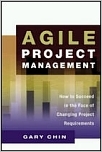| |||||
• polskie
• Zamów informacje o nowościach z wybranego tematu • kontakt |
AGILE PROJECT MANAGEMENTG.CHINwydawnictwo: MCGRAW HILL, 2004, wydanie Icena netto: "Jim Highsmith is one of a few modern writers who are helping us understand the
new nature of work in the knowledge economy." "This is the project management book we've all been waiting for-the book that
effectively combines Agile methods and rigorous project management. Not only does this
book help us make sense of project management in this current world of iterative,
incremental Agile methods, but it's an all-around good read! "Finally a book that reconciles the passion of the Agile Software movement with
the needed disciplines of project management. Jim's book has provided a service to all of
us." "The world of product development is becoming more dynamic and uncertain. Many managers cope by reinforcing processes, adding documentation, or further honing costs. This isn't working. Highsmith brilliantly guides us into an alternative that fits the times." Preston G. Smith, principal, New Product Dynamics/coauthor, Developing Products in Half the Time Now, one of the field's leading experts brings together all the knowledge and resources you need to use APM in your next project. Jim Highsmith shows why APM should be in every manager's toolkit, thoroughly addressing the questions project managers raise about Agile approaches. He systematically introduces the five-phase APM framework, then presents specific, proven tools for every project participant. Coverage includes:
JIM HIGHSMITH is Director, Agile Project Management Practice, and Fellow, Business Technology Council at Cutter Consortium. He is also a Member of the Software Development Productivity Council, Flashline, Inc. Highsmith authored Adaptive Software Development, which won the prestigious Jolt award for excellence, and Agile Software Development Ecosystems (Addison Wesley). A recognized leader in the Agile movement, he co-authored the Agile Manifesto and co-founded the Agile Alliance. Table of Contents Preface. 1. The Agile Revolution. 2. Guiding Principles: Customers and Products. 3. Guiding Principles: Leadership-Collaboration Management. 4. An Agile Project Management Model. 5. The Envision Phase. 6. The Speculate Phase. Scope Evolution. Phase: Speculate. Practice: Product Feature List. Practice: Feature Cards. Practice: Performance Requirements Cards. Practice: Release, Milestone, and Iteration Plan. Speculate Summary. 7. The Explore Phase. 8. The Adapt and Close Phases. 9. Building Large Adaptive Teams. 10. Reliable Innovation. Bibliography. Index. Hardcover Księgarnia nie działa. Nie odpowiadamy na pytania i nie realizujemy zamówien. Do odwolania !. |


